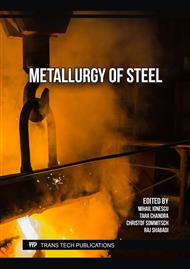[1]
M. Rieth, M. Schirra, A. Falkenstein, P. Graf, S. Heger, H. Kempe, R. Lindau, H. Zimmermann, EUROFER 97 Tensile, Charpy, Creep and Structural Tests. Report FZKA6911, Eurofusion programme, 2003.
Google Scholar
[2]
K.D. Zilnyk, V.B. Oliveira, H.R.Z. Sandim, A. Möslang, D. Raabe, Martensitic transformation in Eurofer-97 and ODS-Eurofer steels: A comparative study, Journal of Nuclear Materials, 462 (2015) 360–367.
DOI: 10.1016/j.jnucmat.2014.12.112
Google Scholar
[3]
J. Hoffmann, M. Rieth, M. Klimenkov, S. Baumgärtner, Improvement of EUROFER's mechanical properties by optimized chemical compositions and thermo-mechanical treatments, Nuclear Materials and Energy, 16 (2018) 88–94.
DOI: 10.1016/j.nme.2018.05.028
Google Scholar
[4]
G. Stornelli, M. Rallini, C. Testani, R. Montanari, A. Di Schino, G. Stornelli, R. Montanari, C. Testani, A. Di Schino, Effect of thermo-mechanical treatment on EUROFER 97 steel for nuclear fusion application, La Metallurgia Italiana, 112(10) (2020) 34–44.
DOI: 10.4028/www.scientific.net/msf.1016.1392
Google Scholar
[5]
X. Chen, A. Bhattacharya, M.A. Sokolov, L.N. Clowers, Y. Yamamoto, T. Graening, K.D. Linton, Y. Katoh, M. Rieth, Mechanical properties and microstructure characterization of Eurofer97 steel variants in EUROfusion program, Fusion Engineering and Design, 146 (2019) 2227–2232.
DOI: 10.1016/j.fusengdes.2019.03.158
Google Scholar
[6]
G. Stornelli, R. Montanari, C. Testani, L. Pilloni, G. Napoli, O. Di Pietro, A. Di Schino, Microstructure refinement effect on EUROFER 97 steel for nuclear fusion application, Materials Science Forum, 1016 MSF (2021) 1392–1397.
DOI: 10.4028/www.scientific.net/msf.1016.1392
Google Scholar
[7]
S.J. Zinkle, A. Möslang, Evaluation of irradiation facility options for fusion materials research and development, in: Fusion Engineering and Design, 2013: p.472–482.
DOI: 10.1016/j.fusengdes.2013.02.081
Google Scholar
[8]
A. Di Schino, C. Testani, L. Pilloni, Effect of thermo-mechanical parameters on the mechanical properties of Eurofer97 steel for nuclear applications, Open Engineering, 8 (2018) 349–353.
DOI: 10.1515/eng-2018-0040
Google Scholar
[9]
G. Stornelli, M. Gaggiotti, D.M. Gattia, R. Schmidt, M. Sgambetterra, A. Tselikova, G. Zucca, A. Di Schino, Vanadium alloying in s355 structural steel: effect on residual austenite formation in welded joints heat affected zone, Acta Metallurgica Slovaca, 28(3) (2022) 127–132.
DOI: 10.36547/ams.28.3.1535
Google Scholar
[10]
G. Stornelli, A. Tselikova, D. Mirabile Gattia, M. Mortello, R. Schmidt, M. Sgambetterra, C. Testani, G. Zucca, A. Di Schino, Influence of Vanadium micro-alloying on the microstructure of structural high strength steels welded joints, Materials, 16(7) (2023) 2897
DOI: 10.3390/ma16072897
Google Scholar
[11]
A. Di Schino, M. Gaggiotti, D. Mirabile Gattia, R. Schmidt, M. Sgambetterra, G. Stornelli, C. Testani, A. Tselikova, G. Zucca, Vanadium micro-alloying effect on heat affected zone microstructure in welded joints for structural applications, La Metallurgia Italiana, 113 (2022) 8–14.
DOI: 10.3390/ma16072897
Google Scholar
[12]
A.A.F. Tavassoli, E. Diegele, R. Lindau, N. Luzginova, H. Tanigawa, Current status and recent research achievements in ferritic/martensitic steels, Journal of Nuclear Materials, 455 (2014) 269–276.
DOI: 10.1016/j.jnucmat.2014.06.017
Google Scholar
[13]
K. Mergia, N. Boukos, Structural, thermal, electrical and magnetic properties of Eurofer 97 steel, Journal of Nuclear Materials, 373 (2008) 1–8.
DOI: 10.1016/j.jnucmat.2007.03.267
Google Scholar
[14]
R. Coppola, M. Klimenkov, Dose dependence of micro-voids distributions in low-temperature neutron irradiated Eurofer97 steel, Metals (Basel), 9 (2019) 1–12.
DOI: 10.3390/met9050552
Google Scholar
[15]
C. Cristalli, L. Pilloni, O. Tassa, L. Bozzetto, Mechanical properties of several newly produced RAFM steels with Tungsten content in the range of 2 wt%, Nuclear Materials and Energy, 25 (2020) 100793.
DOI: 10.1016/j.nme.2020.100793
Google Scholar
[16]
V.B. Oliveira, H.R.Z. Sandim, D. Raabe, Abnormal grain growth in Eurofer-97 steel in the ferrite phase field, Journal of Nuclear Materials, 485 (2017) 23–38.
DOI: 10.1016/j.jnucmat.2016.12.019
Google Scholar
[17]
L. Pilloni, C. Cristalli, O. Tassa, I. Salvatori, S. Storai, Grain size reduction strategies on Eurofer, Nuclear Materials and Energy, 17 (2018) 129–136.
DOI: 10.1016/j.nme.2018.06.023
Google Scholar
[18]
G. Stornelli, A. Di Schino, S. Mancini, R. Montanari, C. Testani, A. Varone, Grain refinement and improved mechanical properties of eurofer97 by thermo-mechanical treatments, Applied Sciences (Switzerland), 11 (2021) 10598.
DOI: 10.3390/app112210598
Google Scholar
[19]
S. Mancini, L. Langellotto, P.E. Di Nunzio, C. Zitelli, A. Di Schino, Defect reduction and quality optimization by modeling plastic deformation and metallurgical evolution in ferritic stainless steels, Metals (Basel), 10(2) (2020) 186.
DOI: 10.3390/met10020186
Google Scholar
[20]
R.E.; Reed-Hill, R. Abbaschian, L. Abbaschian, Physical Metallurgy Principles, 1973.
Google Scholar
[21]
E. Materna-Morris, H.C. Schneider, A. Möslang, Tensile behavior of RAFM alloys after neutron irradiation of up to 16.3 dpa between 250 and 450 °C, Journal of Nuclear Materials, 455 (2014) 728–734.
DOI: 10.1016/j.jnucmat.2014.08.054
Google Scholar



